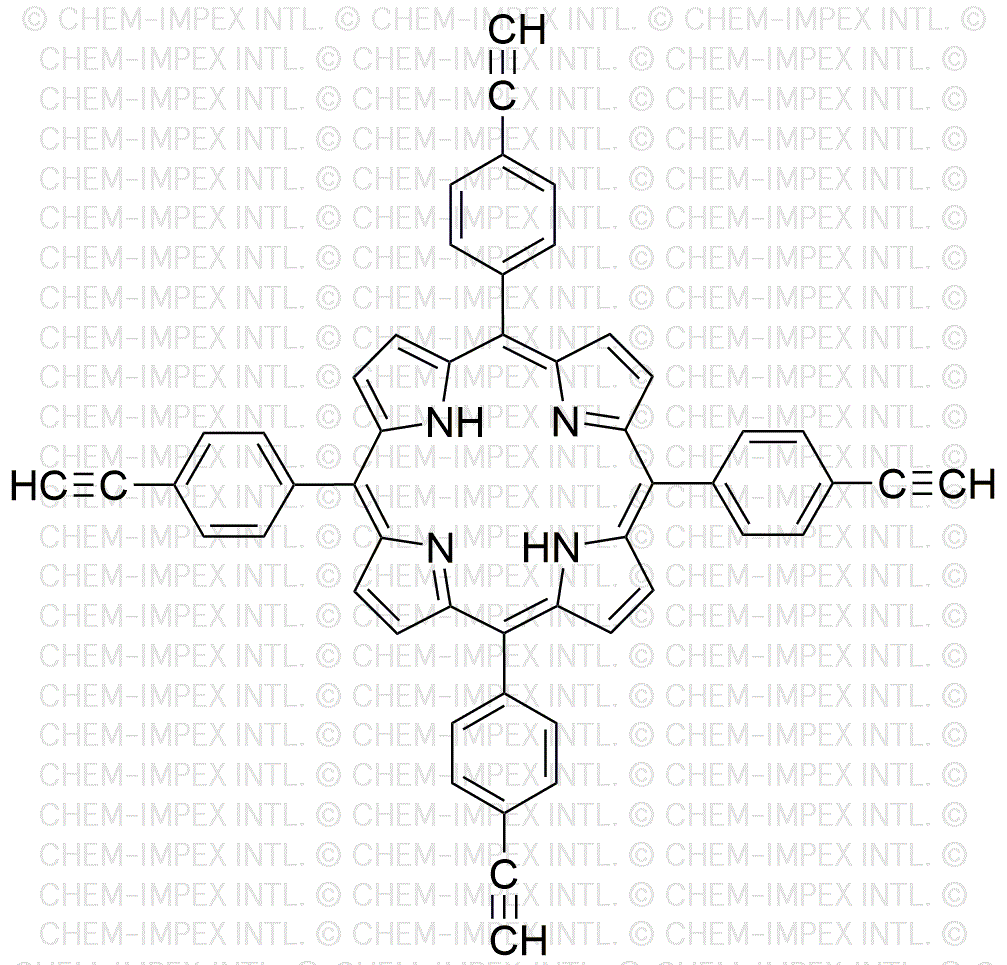5,10,15,20-(Tetra-4-ethynylphenyl)porphyrin is widely utilized in research focused on:
- Photodynamic Therapy: This compound is effective in targeting cancer cells. Its ability to absorb light allows it to generate reactive oxygen species when illuminated, which can selectively destroy tumor cells.
- Solar Energy Conversion: It serves as a key component in organic solar cells. The compound's unique structure enhances light absorption and energy transfer, improving the efficiency of solar energy conversion.
- Sensors and Biosensors: Its properties make it suitable for developing sensors that detect environmental pollutants or biological markers, providing a reliable method for monitoring health and safety.
- Organic Electronics: This chemical is used in the fabrication of organic light-emitting diodes (OLEDs) and organic photovoltaics, contributing to advancements in flexible and lightweight electronic devices.
- Research in Catalysis: It plays a role in catalyzing various chemical reactions, particularly in organic synthesis, offering a more efficient pathway compared to traditional catalysts.
Informations générales
Propriétés
Sécurité et réglementation
Applications
5,10,15,20-(Tetra-4-ethynylphenyl)porphyrin is widely utilized in research focused on:
- Photodynamic Therapy: This compound is effective in targeting cancer cells. Its ability to absorb light allows it to generate reactive oxygen species when illuminated, which can selectively destroy tumor cells.
- Solar Energy Conversion: It serves as a key component in organic solar cells. The compound's unique structure enhances light absorption and energy transfer, improving the efficiency of solar energy conversion.
- Sensors and Biosensors: Its properties make it suitable for developing sensors that detect environmental pollutants or biological markers, providing a reliable method for monitoring health and safety.
- Organic Electronics: This chemical is used in the fabrication of organic light-emitting diodes (OLEDs) and organic photovoltaics, contributing to advancements in flexible and lightweight electronic devices.
- Research in Catalysis: It plays a role in catalyzing various chemical reactions, particularly in organic synthesis, offering a more efficient pathway compared to traditional catalysts.
Documents
Fiches de données de sécurité (FDS)
La FDS fournit des informations de sécurité complètes sur la manipulation, le stockage et l’élimination du produit.
Spécifications du produit (PS)
Le PS fournit une description complète des propriétés du produit, notamment sa composition chimique, son état physique, sa pureté et les exigences de stockage. Il détaille également les plages de qualité acceptables et les applications prévues du produit.
Certificats d'analyse (COA)
Recherchez des certificats d'analyse (COA) en saisissant le numéro de lot du produit. Les numéros de lot et de lot se trouvent sur l'étiquette d'un produit, après les mots « Lot » ou « Lot de fabrication ».
Numéro de catalogue
Numéro de lot/série
Certificats d'origine (COO)
Ce certificat d'exploitation confirme le pays dans lequel le produit a été fabriqué, et détaille également les matériaux et composants utilisés et s'il est issu de sources naturelles, synthétiques ou autres sources spécifiques. Ce certificat peut être requis pour les douanes, le commerce et la conformité réglementaire.
Numéro de catalogue
Numéro de lot/série
Fiches de données de sécurité (FDS)
La FDS fournit des informations de sécurité complètes sur la manipulation, le stockage et l’élimination du produit.
DownloadSpécifications du produit (PS)
Le PS fournit une description complète des propriétés du produit, notamment sa composition chimique, son état physique, sa pureté et les exigences de stockage. Il détaille également les plages de qualité acceptables et les applications prévues du produit.
DownloadCertificats d'analyse (COA)
Recherchez des certificats d'analyse (COA) en saisissant le numéro de lot du produit. Les numéros de lot et de lot se trouvent sur l'étiquette d'un produit, après les mots « Lot » ou « Lot de fabrication ».
Numéro de catalogue
Numéro de lot/série
Certificats d'origine (COO)
Ce certificat d'exploitation confirme le pays dans lequel le produit a été fabriqué, et détaille également les matériaux et composants utilisés et s'il est issu de sources naturelles, synthétiques ou autres sources spécifiques. Ce certificat peut être requis pour les douanes, le commerce et la conformité réglementaire.


